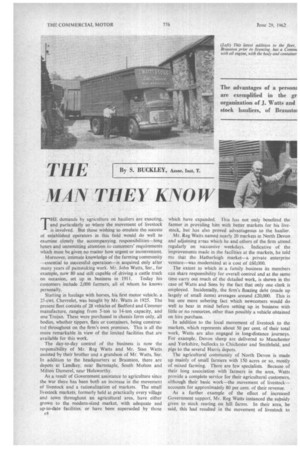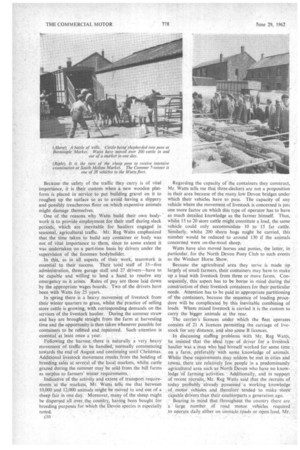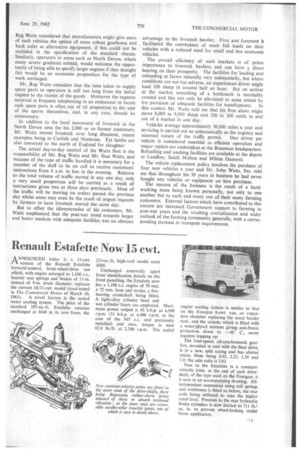THE By S. BUCKLEY, Assoc. Inst. T.
Page 72

Page 73

Page 74

Page 77

If you've noticed an error in this article please click here to report it so we can fix it.
ILIN THEY KNOW THE demands by agriculture on hauliers are exacting, and particularly so where the movement of livestock is involved. But those wishing to emulate the success of established operators in this field would do well to examine closely • the accompanying responsibilities—long hours and unremitting attention to customers' requirements which must be given. no matter how urgent or inconvenient. Moreover, intimate knowledge of the farming community —essential to successful operation—is acquired. only after many years of painstaking work. Mr. John Watts, Snr., for example, now 80 and still capable of driving a cattle truck
on occasion, set up in business in 1911. Today his customers include 2,000 farmers, all of whom he knows personally.
Starting in haulage with horses, his first motor vehicle, a 25-cwt. Chevrolet, was bought by Mr. Watts in 1925. The present fleet consists of 28 vehicles of Bedford and Commer manufacture, ranging from 5-ton to 14-tort capacity, and one Trojan. These were purchased in chassis form only, all bodies, whether tippers, flats or containers, being construetd throughout on. the firm's own. premises. This is all the more remarkable, in view of the limited facilities that are available for this work.
The day-to-day control of the business is now the responsibility of Mr. Reg Watts and Mr. .Stan Watts assisted by their brother and a grandson of Mr. Watts, Snr. In addition to the headquarters at 13raunton, there are depots at Landk.ey, near Barnstaple, South Mahon and Milton Damerel, near HoIsworthy.
As a result of Government assistance to agriculture since the war there has been both an increase in the movement of livestock' and a rationalization of markets. The small livestock markets, formerly held at practically every village and town throughout an agricultural area, have either grown to the modern-sized market, with adequate and up-to-date facilities, or have been superseded .by those
which have expanded. This has not only benefited the farmer in providing him with better markets for his livestock, but has also proved advantageous to the haulier.
Mr. Reg Watts named nearly 20 markets in North Devon and adjoining areas which he and others of the firm attend regularly on successive weekdays. Indicative of the improvements made in the facilities at the markets, he told me that the Hatherleigh market—a private enterprise venture—was modernized at a cost of .£60,000.
The extent to which in a family business its members can share responsibility for overall control and at the same time carry out much of the detailed work, is shown in the case of Watts and Sons by the fact that only one clerk is employed. Incidentally, the firm's floating debt (made up laigely of small items) averages around £20,000. This is but one more sobering fact which newcomers would do well to bear in mind before setting up in business with little or no resources, other than possibly a vehicle obtained on hire purchase.
In addition to the local movement of livestock to the markets, which represents about 50 per cent. of their total work, Watts are also engaged in long-distance journeys. For example, Devon sheep are delivered to Manchester and Yorkshire, bullocks to Chichester and Smithfield, and pigs to the several Harris depots.
The agricultural community of North Devon is made up mainly of small farmers with 150 acres or so, mostly of mixed farming. There are few specialists. Because of their long association with farmers in the area, Watts provide a complete service for their agricultural customers, although their basic work—the movement of livestock-accounts for approximately 80 per cent of their revenue.
As a further example of the effect of increased Government support, Mr. Reg Watts instanced the subsidy given to stock rearing on hill farms. In their area, he said, this had resulted in the movement of livestock to and from the upper ieaches of Exmoor for a few months each summer.
The Comrners in the fleet are all 7-tonners constructed to permit the loading of a 20-ft. container when required. One of these is fitted with a Boys third axle and is thus able to carry a 26-ft. container. This vehicle has now proved its worth, having run over 100.000 miles on trunking livestock to Salisbury and London.
A number of vehicles have Baico extensions. The 5-ton Bedfords have 16-ft. platforms and the 7-tanners platforms of 18 ft. 6 in. There is also a 5-ton Bedford tipper.
A vehicle of particular interest is a four-wheel-drive Bedford which can carry 5 cu. yd. of material or its equivalent. Special jobs undertaken by this vehicle include a two-mile run across the Braunton sands to maintain supplies to the local lighthouse. It is also indispensable when dead animals have to be collected, often from otherwise inaccessible ditches and similar places.
There are 23 containers available for use throughout the fleet, whilst two vehicles are permanently fitted out as livestock transporters. Because of its cheapness, the basic material used by Watts in constructing their own bodywork and containers is wood. Occasionally Mr. Reg Watts has experimented with alloy construction, but he has continued with wood, although he retains the aluminium alloy uprights which show a substantial saving in weight compared with those in other metals. Whilst recognizing the longer life which the alloy provided and the ease with which it could be cleaned, Mr. Reg Watts considers that it is not an economic proposition to use overall alloy construction while the price differential remains around £200 in favour of wood. Because the safety of the traffic they carry is of vital importance, it is their custom when a new wooden platform is placed in service to put building gravel on it to roughen up the surface so as to avoid having a slippery and possibly treacherous floor on which expensive animals might damage themselves.
One of the reasons why Watts build their own bodywork is to provide employment for their staff during slack periods, which are inevitable for hauliers engaged in seasonal, agricultural traffic. Mr. Reg Watts emphasized that the time taken to build any container or body was not of vital importance to them, since to some extent it was undertaken on a part-time basis by drivers under the supervision of the foreman bodybuilder.
In this, as in all aspects of their work, teamwork is essential to their success. Their total staff of 35—five administration, three garage staff and 27 drivers—have to be capable and willing to lend a hand, to resolve any emergency as it arises. Rates of pay are those laid down by the appropriate wages boards. Two of the drivers have been with Watts for ,25 years.
In spring there is a heavy movement of livestock from their winter quarters to grass, whilst the practice of selling store cattle is growing, with corresponding demands on the services of the livestock haulier. During the summer straw and hay are brought straight from the farm at harvesting time and the opportunity is then taken whenever possible for containers to be refitted and repainted. Such attention is essential at least once a year Following the harvest there is naturally a very heavy movement of traffic to be handled, normally commencing towards the end of August and continuing until Christmas. Additional livestock movement results from the holding of breeding sales at several of the local markets, whilst cattle grazed during the summer may be sOld from the hill farms as surplus to farmers' winter requirements.
Indicative of the activityand extent of transport requirements at the markets, Mr. Watts tells me that between 10,000 and 12,000 animals might be moved in and out of a sheep fair in one day. Moreover, many of the sheep might be dispersed all over ,the country, having been bought for breeding purposes for which the Devon species is especially noted. Regarding the capacity of the containers they construct, Mr. Watts tells me that three-deckers are not a proposition in their area because of the many low Devon bridges under which their vehicles have to pass. The capacity of any vehicle where the movement of livestock is concerned is just one more factor on which this type of operator has to have as much detailed knowledge as the farmer himself. Thus, whilst 15 to 20 store cattle might constitute a load, the same vehicle could only accommodate 10 to 15 fat cattle. Similarly, whilst 200 shorn hogs might be carried, this number would be reduced to around 130 if the animals concerned were on-the-wool sheep.
Watts have also moved horses and ponies, the latter, in particular, for the North Devon Pony Club to such events as the Windsor Horse Show.
Because the agricultural area they serve is made up largely of small farmers, their containers may have to make up a load with livestock from three or more farms. Consequently, this aspect has to be borne in mind during the construction of their livestock containers for their particular needs. Attention has to be paid to appropriate partitioning of the containers, because the sequence of loading procedure will be complicated by this inevitable combining of loads. Where mixed livestock is carried it is the custom to carry the bigger animals at the rear.
The carrier's licences under which the fleet operates consists of 21 A licences permitting the carriage of livestock for anydistance, and also some B licences.
In discussing staffing problems with Mr. Reg Watts, he insisted that the ideal type of• driver for a Iive4ock• haulier was a man who had' himself worked for some time on a farm, preferably with some knowledge of animals. . Whilst these requirements may seldom be met in cities and towns, there are relatively few people in a predominantly agricultural area such as .North Devon who have no knowledge of farming • activities. Additionally, and in support of recent recruits,. Mr. Reg Watts said that Abe recruits of ' today probably "'already possessed a working knowledge of motor .vellioles and therefore tended to make more capable drivers than their counterparts a generation ago.
Bearing in mind that throughout the country there are a large number of road motor vehicles required' to operate daily either on unmade roads or open land, Mr. Reg Watts considered that manufacturers might give users of such vehicles the option of more robust gearboxes and back axles as alternative equipment, if this could not be included in the specification of the standard chassis. Similarly, operators in areas such as North Devon, where many severe gradients existed, would welcome the opportunity of being able to specify larger engines if they thought this would be an economic proposition for the type of work envisaged.
Mr._Reg Watts considers that the time taken to supply spare parts to operators is still too long from the initial request to the receipt of the goods. Moreover the expense incurred in frequent telephoning in an endeavour to locate such spare parts is often out of all proportion to the cost of the spares themselves, and, in any case, should be unnecessary.
In addition to the local movement of livestock in the North Devon area for his 2,000 or so farmer customers, Mr. Watts moves livestock over long distances, recent examples being to Carlisle and Montrose. Fat lambs are also conveyed to the north of England for slaughter.
The actual day-to-day control of the Watts fleet is the responsibility of Mr. Reg Watts and Mr. Stan Watts, and because of the type of traffic handled it is necessary for a member of the staff to be on call to receive customers' instructions from 6 a.m. to late in the evening. Relative to the total volume of traffic moved in any one day, only a very small proportion will be carried as a result of instructions given two or three days previously. Most of the traffic will be moving on orders passed the previous day whilst some may even be the result of urgent. requests by farmers to have livestock moved the same day.
But to offset the idiosyncrasies of his customers, Mr Watts emphasized that the post-war trend towards larger and better markets with adequate facilities was an obvious advantage to the livestock haulier. First and foremost it facilitated the conveyance of more full loads on their vehicles with a reduced need for small and less economic vehicles.
The overall efficiency of such markets is of prime importance to livestock hauliers and can have a direct bearing on their prosperity. The facilities for loading and unloading at farms naturally vary substantially, but where conditions are not too adverse, an experienced driver might load 100 sheep in around half an hour. But on arrival at the market something of a bottleneck is inevitably created and this can only be alleviated to some extent by the provision of adequate facilities for transhipment. In this context Mr. Watts told me that his firm alone might move 8,000 to 9,000 sheep and 200 to 300 cattle in and out of a market in one day.
Vehicles average approximately 30,000 miles a year and servicing is carried out as systematically as the urgency and seasonal nature of the traffic permit. One driver per vehicle is considered essential to efficient operation and major repairs are undertaken at the Braunton headquarters. Refuelling and washing facilities are available at the depots at Landkey, South Molton and Milton Damerel.
The vehicle replacement policy involves the purchase of four new vehicles a year and Mr. John Watts, Snr. told me that throughout his 50 years in business he had never bought any vehicles or equipment on hire purchase.
The success of the business is the result of a hardworking team being known personally, not only to one another but to each and every one of their many farming customers. External factors which have contributed to this success are increased Government support to farming in post-war years and the resulting centralization and wider outlook of the farming community generally, with a corresponding increase in transport requirements.
















































































































































